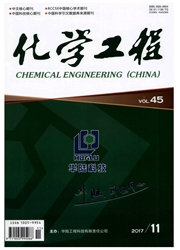

 中文摘要:
中文摘要:
基于欧拉法和流体体积函数建立了描述相界面运动、变形、破碎等复杂变化的界面追踪模型(VOF-CSF),该模型采用了二相界面重构技术,并考虑了界面张力和接触角的影响,将水在非相溶油中滴流雾化形成液滴过程简化为二维轴对称数值模拟,模拟了层流环境中低喷射流率下液滴形成的全过程。模拟结果表明:在滴流雾化方式下,液滴形成过程由液滴受力平衡机制控制,并需经历长大、拉伸、缩颈、脱离和卷缩5个微观过程,其形成的时刻与位置具有随机性,液滴顶部位置的波动幅度比液滴断裂点处小。最后,通过试验对比发现,模拟再现的层流环境中低喷射流率下油-水相界面运动、变形、破碎等微观特征,以及所获得的液滴粒径分布特征均与试验结果吻合较好,表明所建模型可以对不同工况下滴流形成液滴的过程进行预测。
 英文摘要:
英文摘要:
The liquid-liquid interface tracking model (VOF-CSF) was set up to describe the movement, deformation and breakup of interfaces in liquid-liquid system with the help of the Euler method and volume function of fluid, in which the arithmetic was applied in interpolation near the interface. The effects of surface tension and the contact angle were also considered. The 2D axial symmetry grid model was simplified and built on water trickling atomization in another immiscible oil. Based on the model, the drop formation of water atomization in laminar flow oil with the low flow was simulated. The result shows that under the type of trickling atomization the drop formation is dominated by balanced-force mechanism, and there are five micro-stages as growing, stretching necking, detaching, recoiling in the process of drop formation, in which the drop formation time and position have randomicity. Compared with fluctuation amplitude at drop breakup, the fluctuation amplitude at drop top is small. The simulation results show that the microscopic feature of the movement, deformation and breakup of oil-water two-phase interfaces and drop size distribution are quite in conformity with the experimental data. Moreover, comparative analysis shows that the model and the computational program presented are reliable for predicting drop of atomization under different conditions.
 同期刊论文项目
同期刊论文项目
 同项目期刊论文
同项目期刊论文
 期刊信息
期刊信息
